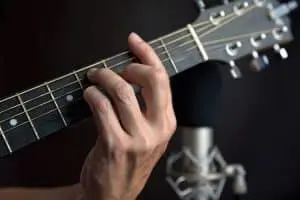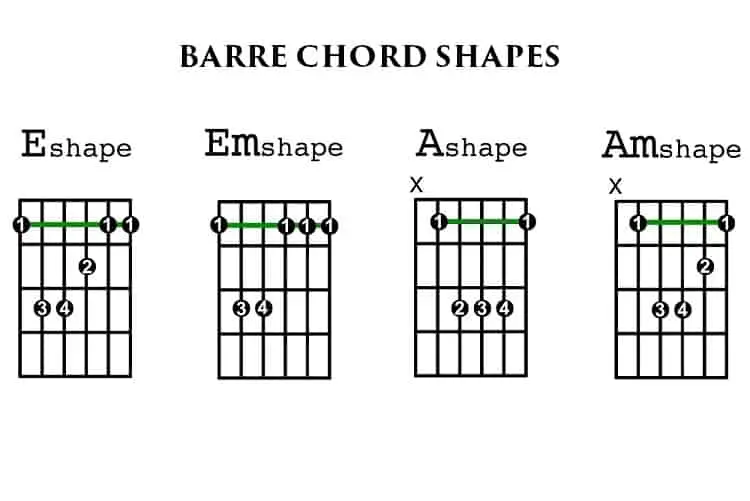 The main big benefit of knowing barre chords appears to be the freedom of playing a chord on few guitar neck places.
The main big benefit of knowing barre chords appears to be the freedom of playing a chord on few guitar neck places.
So, before you learn to play all barre chords, you must firstly understand and know all possible barre shapes.
Because the reason they’re built is that you can truly put them into the right context of your own music creations.
E Shape
What is the main characteristic of the
“E shape”?
Well, some players fear this one like the dreaded and potentially problematic “F”.
The finger fretboard formation is moved smoothly up beyond 1st feet, or exactly there, and that means you have to really barre your index finger if you want to represent where your nut must be positioned in relation with those fretted strings.
E shape characteristics
The 6th string is always the root note that is lowest here. So, in the case of the root note positioned on the 5th fret, then it is clearly major A chord because the root tone is than A. It is F major in the case of the fret that is 1st, and so on. E minor shape is also present and it’s firmly based on that open type of E minor, and all that you need to do is to lift your 2nd finger away from major if you want this one.
There are also higher types of root notes in this shape, they are on 1st and the 4th strings. But in this part, it’s very easy to identify barre chords root if you take a look at their root note that is the lowest. Because all the rest is really built from this particular point when it comes to E shape.

A Shape
Really the same procedure as above, but in this case, the chord is completely based on some open A minor/major shapes. Barre chord A shape in it’s relation to some open Amaj shape is an interesting thing because this time, the root of the bass is positioned on the string. So it’s this root of the string that truly determines what note you use in the chord naming.
For the A major shape, the barrel it’s easy and smooth to 4th, 3rd, and 2nd strings if you use 3rd/ring finger or if you also leave out that 1st one. Also, you can mostly guess where that C shape kinds of barre chords really come from. The answer cannot be more simple – the open kind of C major that beginners learn.
C shape
This one provides you with a different voicing than the A shape, well, even though this one is firmly rooted on that same 5th. And, unlike previous A shape that ascends directly from those root position, this C shape completely descends from it. And there is the absence of minor C for learning because of those fingers formation in this one.
Other Shapes and Conclusion
Well, there are some teachers and players that often refer to further shapes of the barre chord – those are G and D. But they are not so worthy of your time as those mentioned in this text because the mammoth G shape is hard to finger in this position.
So, I think that this text about barre chord shapes will help you a bit and leave you more satisfied than before.
